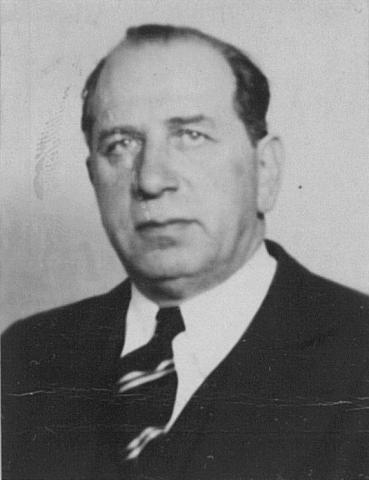After Moritz Lindemann had worked as a goldsmith and jewel designer and then as a quick-sketch artist in Viennese and Berlin cabarets, he opened his own art dealership specializing in Old Masters in Vienna in 1911. He attended a course at the Akademie der bildenden Künste in Wien (Academy of Fine Arts in Vienna) with the restorer Serafin Maurer (1865–1945), who mentioned Lindemann's good eye for authenticity and the value of art objects. Lindemann was in demand as a result as an art expert for museums in Austria and other countries. His special talents included an ability to recognize overpainted pictures and in this way to detect works by Old Masters, giving him the nickname "the man with x-ray eyes". He was particularly active in the 1920s in major museums in Vienna, Berlin, Belgium and the Netherlands. As a Jew, he no longer felt safe in Vienna after the annexation in 1938. In October 1938, the company Otto Lautenbacher (vorm. Franz Kurt Levai), where Lindemann also worked, therefore applied to the Belgian consulate general for a visa for a business trip to visit customers and sign new delivery contracts. Lindemann, who also applied in November, was given a three-month visa to deal with art business. In 1938 and 1939 his family made several applications to the Zentralstelle für Denkmalschutz (Central Monument Protection Authority) for permission to export artworks, all of which were granted. In 1939 Lindemann travelled via Zurich and Britain to Belgium, where he was able to continue business and intensify his contacts, among others with Léo Van Puyvelde, art historian and head restorer at the Royal Museum of Fine Arts in Brussels. He donated two valuable paintings from the Dutch School to this museum in 1941. After Lindemann had been included in the Belgian "register of Jews" in 1941, he sought exemption the following year from the obligation to wear the Jewish star, backed by references or earlier certification from prominent curators and directors of Viennese museums. The references were basically positive, highlighting in particular his generosity, for example, with regard to the Österreichische Galerie. Gert Adriani, director of the Picture Gallery at the Kunsthistorisches Museum (KHM) in Vienna, was the only person to question Lindemann's business practices, although the KHM had also benefited from his donations. Lindemann's contacts extended beyond the art world, however. When he was interned in June 1943 in the camp in Mechelen, he was released after just a few days through the intervention of the Belgian queen Elisabeth. In the end, nothing helped. Already in poor health, Lindemann was summoned to the Gestapo in January 1944. There is no further information about his fate from then on. On 15 February 1951, the Belgian Ministry for Reconstruction determined that he had died between 2 January 1944 and 1 June 1945. The whereabouts of the six paintings which the Brüsseler Treuhandgesellschaft set up by the Nazi occupiers removed from his apartment in Brussels in 1944 are also unknown today.
Moritz Lindemann

Oscar Friedmann (Hg.), Prominentenalmanach 1, Wien-Leipzig 1930.
Edwin Lachnit, Ringen mit dem Engel. Anton Kolig, Franz Wiegele, Sebastian Isepp, Gerhart Frankl, Wien-Köln-Weimar 1998.
Archiv der IKG, Matriken, Moritz Lindemann.
Archiv der Österreichischen Galerie Belvedere, Wien, Archiv Werner J. Schweiger, Moriz Lindemann.
Archiv der Wirtschaftskammer Österreich, Gewerberegister, Nr. 16.197; Nr. 27.956.
Archives of Royal Palace, Brussels, Secrétariat de la reine Élisabeth, 74/2.
BDA-Ausfuhr, Zl. 2001/1939, Emma Lindemann.
BDA-Ausfuhr, Zl. 574/1938, Hans Lindemann.
BDA-Ausfuhr, Zl. 5517/1938, Lindemann.
BDA-Ausfuhr, Zl. 8878/1938, Moritz Lindemann.
KHM-Archiv, 152/ED/1942.
KHM-Archiv, Gemäldegalerie, oZ1/GG/1942.
Museums of Fine Arts of Belgium, Archiv, Zl. 6090/2/128 (1939).
National Archives of Belgium, Police des Estrangers, Nr. A321.049.
OeStA/AdR, E-uReang, Abwicklungsstelle der Vermögensverkehrsstelle, Vugesta-Geschäftsbücher, Buch 7, Nr. 3764, Lindemann Emma und Grete.
OeStA/AdR, E-uReang, FLD, Zl. 3332, Emma und Margarethe Lindemann.
RKD Netherlands Institute for Art History, Max J. Friedländer Archive, RKD, The Hague, Notebook M.J. Friedländer, 1945/46, inv.nr. 306; Max J. Friedländer Archive, RKD, The Hague, Notebook M.J. Friedländer, 1939, inv.nr. 300.
SLA, HS 926/12, Schriftverkehr Kolig I, 110.
SPF Sécurité Sociale – DG Victimes de Guerre, Service Archives et Documentation, Bruxelles, Personal file «SDR» issued by the Archives and Documentation Service in the name of LINDEMANN Moritz, born on 16/09/1880 (Réf. SVG-dalpha).
SPF Sécurité Sociale – DG Victimes de Guerre, Service Archives et Documentation, Bruxelles, Original German card issued by the Sipo-SD (Sicherheitspolizei-Sicherheitsdienst) in the name of LINDEMANN Moritz, born on 16/09/1880 (Réf. SVG-SD 120902-lindemann-moriz).
WStLA, Historische Wiener Meldeunterlagen, Meldeauskunft Moritz Lindemann.
